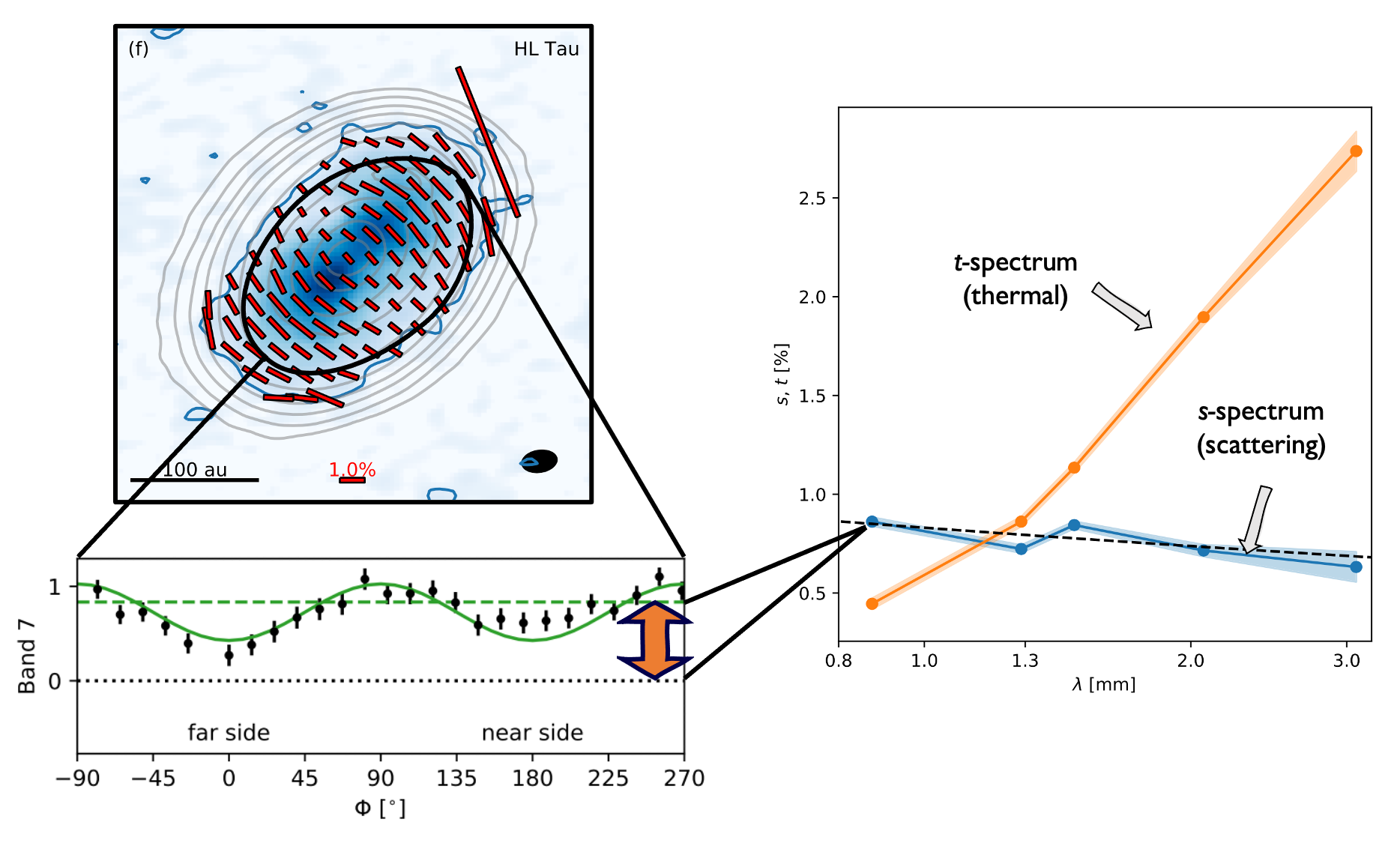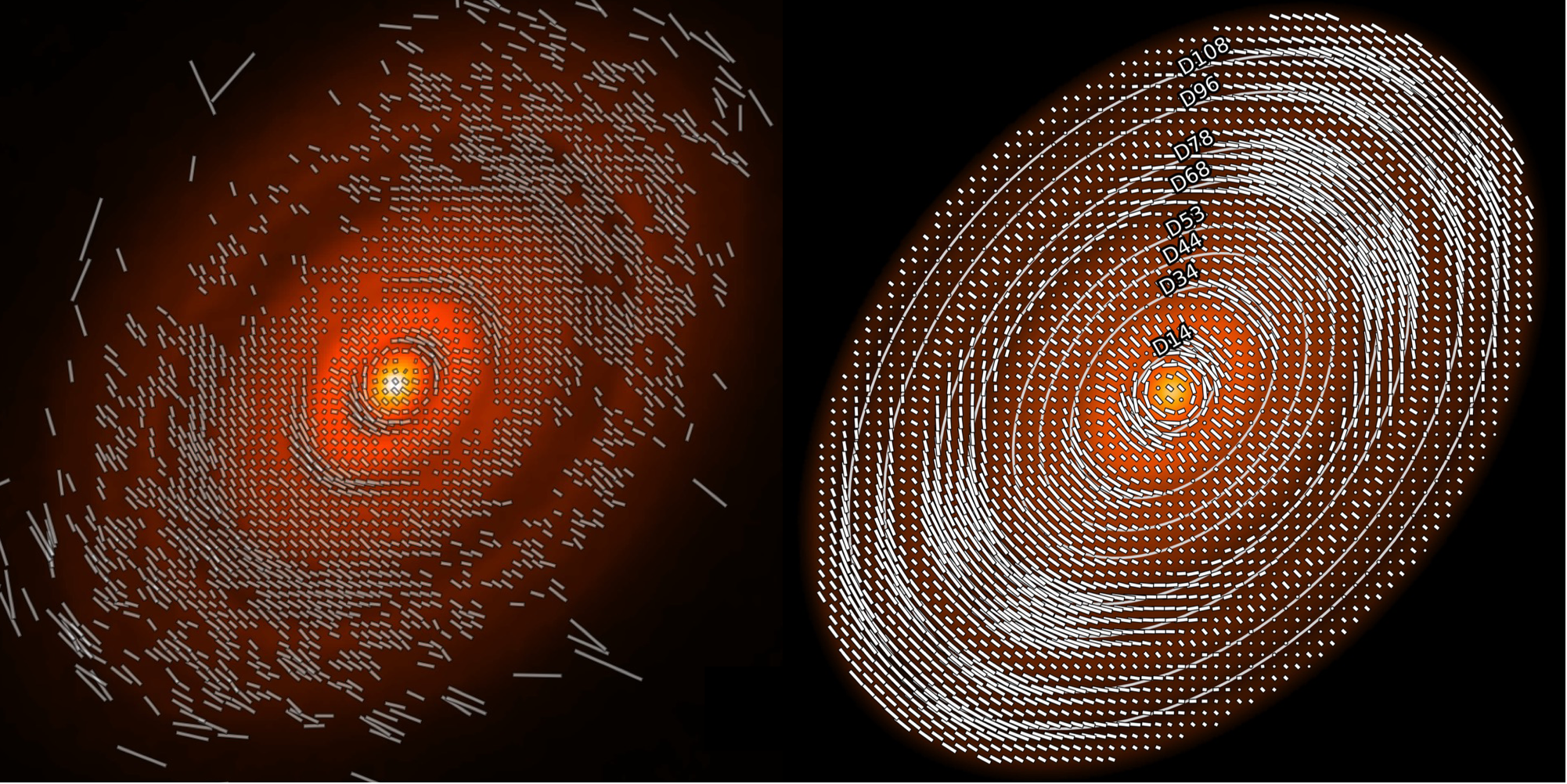Scattering of Aligned Grains 排列塵粒之散射
The origin of (sub)millimeter wave polarization in protoplanetary disks has long been a subject of intense study in astrophysics. Recent advancements in observational techniques have allowed us to resolve dust polarization across circumstellar disks at multiple wavelengths, providing crucial insights into the polarization spectrum and the underlying physical processes. 原行星盤中,次毫米波偏振光的起源一直以來是天體物理學中深入研究的課題之一。觀測技術的最新進展使我們能夠在多個波長上解析環星盤的塵埃偏振,為偏振光譜和潛在的物理過程提供了關鍵的洞見。

Our research on HL Tau, a bright protoplanetary disk, has revealed a fascinating transition in polarization patterns across different wavelengths. At shorter wavelengths (~870μm), we observe a unidirectional polarization pattern indicative of dust scattering, while at longer wavelengths (~3 mm), an elliptical pattern emerges, likely due to aligned grains. This transition can be explained by changes in optical depth: at low optical depths, thermal polarization from aligned grains dominates, while at high optical depths, dichroic extinction effectively reduces thermal polarization, allowing scattering polarization to dominate. By expanding observations to more wavelengths (from 0.87 mm to 7.0 mm), we've confirmed this transition and found that at the longest wavelength (7.0 mm), the polarization is consistent with pure thermal polarization from toroidally aligned prolate grains. 我們對很亮的原行星盤HL Tau的觀測揭示了一個有趣的現象:偏振花紋在不同波長下出現了轉變。在較短波長(870微米)下,我們觀察到單向偏振花紋,指示塵埃散射,而在較長波長(3毫米)下,則出現了橢圓狀花紋,可能由排列塵粒引起。這種轉變可以用光學厚度的變化來解釋:在低光學厚度下,排列塵粒的熱輻射主導偏振光,而在高光學厚度下,雙色消光有效地減少了熱偏振,使偏振由散射偏振主導。我們的研究擴展到更多波長的觀測(從0.87 毫米到7.0毫米),確認了這種轉變,並發現在最長波長(7.0毫米)下,偏振花紋與純粹的環向排列長球體的熱偏振一致。

While polarization from scattering and that from thermal emission of aligned grains should be treated together simultaneously, the field still does not have a code to model a disk in 3D with those effects as of this writing. To overcome the technical barrier, I formulated a technique to disentangle thermal polarization and scattering polarization using the azimuthal variation of the polarization fraction motivated from 1D calculations. My analysis shows that the scattering component decreases slowly with increasing wavelength, while the thermal component increases more rapidly. This behavior follows with expectations from optical depth effects of toroidally aligned scattering prolate grains. The weak wavelength dependence of the scattering component suggests factors beyond simple Rayleigh scattering, such as optical depth effects, disk substructure, and dust porosity, may play important roles. 雖然在模擬散射偏振和排列塵粒熱偏振應該同時處理,但截至目前,該領域仍然缺乏一個能夠在三維模型中同時考慮這些效應的程式碼。為了克服這個技術障礙,我根據一維計算的啟發,利用偏振分度的方位角變化,制定了一種方式來分離熱偏振和散射偏振。我的分析顯示,散射成分隨波長增加而緩慢減少,而熱偏振成分則更快增加。這種行為符合散射的長球體塵粒隨光學厚度的變化,並顯示這些長球體應是環向排列。因為散射成分隨波長僅緩慢減少,簡單的Rayleigh散射之外,光學厚度之效果、盤的細微結構和塵埃孔隙度等因素可能扮演著重要角色。

Recent high-resolution polarization images of HL Tau have resolved the disk's rings and gaps, revealing intricate polarization changes. Gaps show polarization angles with a notable azimuthal component and higher polarization fraction compared to rings. These changes can be explained by variations in optical depth due to surface density differences between rings and gaps. The model I developed suggest that the intrinsic polarization of aligned dust grains may exceed 10%, much higher than previously thought based on low-resolution observations. These findings highlight the importance of considering both scattering and emission from aligned grains when interpreting polarization data and offer a new way to study disk substructure and dust distribution. 最近對HL Tau的高解析度偏振圖像已經解析出盤的環和間隙,揭示了複雜的偏振變化。間隙顯示出具有顯著環向的偏振角度,且相比於環,具有更高的偏振分度。這些變化可以透過環和間隙之間面密度差異導致的光學厚度變化來解釋。我開發的模擬表明,排列塵粒的本質偏振可能超過10%,遠高於先前基於低解析度觀測的測量。這些發現讓我們了解,在解釋偏振圖像時,同時考慮散射偏振和排列塵粒熱偏振的重要性,並為研究盤的細微結構和塵埃分佈提供了新的方法。
Future Directions 未來展望
Our findings solidifies the existence of aligned grains that are large enough to scatter millimeter radiation. The wavelength-dependent transition in polarization patterns provides a powerful tool for probing dust properties. My future research will tackle new challenges to include other factors, such as disk substructure and dust porosity, and improve our ability to characterize grain sizes and grain alignment in protoplanetary disks. 我們的研究結果確證了大到足以散射毫米波輻射的排列塵粒。多波段偏振圖像的變化為探測塵埃特性提供了強大的工具。我未來的研究將挑戰更多複雜因素,如盤細微結構和塵埃孔隙度等,並提高我們對原行星盤中塵粒的理解。